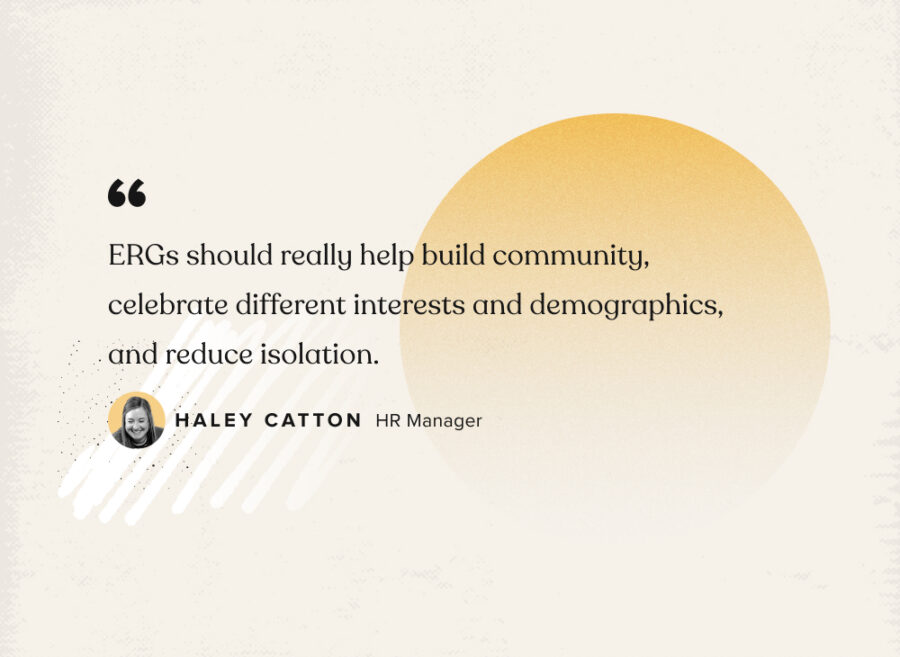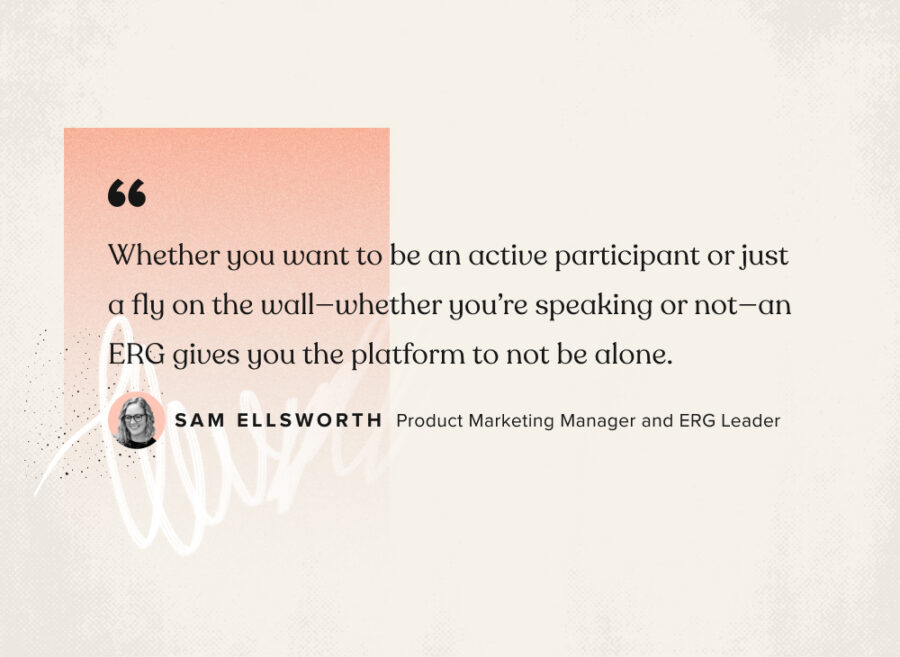Starting an employee resource group (ERG) is as rewarding as it is complex, especially when starting from scratch. You wouldn’t be alone in feeling intimidated by the journey, but honestly, starting an ERG is not as hard as it may seem. While it does require planning and organizing involved on the HR side, ERGs are employee-led and -run by nature. All you have to do as an HR professional is lay the groundwork, establish processes to keep things running smoothly, and offer organizational support.
We’ve been in your shoes and we’ve grappled with the complexities of ERGs. This is a first-hand account on how to start an ERG—a practical roadmap drawn from our real-world experiences from the ground floor of creating Submittable’s ERGs.
ERGs are communities within a company, created by and for employees who share common backgrounds, interests, or experiences. These groups empower individuals to connect with others and share perspectives freely in a dedicated safe space. ERGs also amplify the voices of employees from underrepresented groups, giving them opportunities to advocate for awareness and change at an organizational level.
If you’re looking to introduce ERGs to your team, you’re not alone. About 90% of Fortune 500 companies have ERGs as a part of their organizational culture, but organizations of all sizes can benefit from having these kinds of spaces.
We thought we’d take a step back and reflect on Submittable’s journey in implementing and running ERGs. Our ERGs are employee-run, employee-focused groups that operate as micro-communities within our larger workspace. Based on our experience, we’ve identified a few steps you can follow to start an effective ERG program:
- Measure employee interest
- Secure leadership buy-in
- Define your ERG’s purpose
- Enable employees to join your ERGs
- Establish ERG leaders
- Create safe spaces for discussion
- Provide ongoing support
Prerequisite: ERGs need to be employee-led
The key to creating effective ERGs is right in the name: your employees. ERGs are most successful when employees are able to participate authentically, in an environment based on trust and belonging. To that end, you should empower your employees to lead and run these groups on their own, with minimal company oversight.
The most important quality of any ERG is its ability to foster community, enabling people to show up as themselves and voice their successes or challenges in a space for like-minded people. In order to build that community, let your employees take the reins.
The leaders and participants of Submittable’s ERGs get to decide what their space looks like. Employees are more likely to voice their opinions, participate in discussions, and actively engage in transformative initiatives when they have more ownership and agency within the group. More importantly, by taking a grassroots approach, employee-run ERGs stay attuned to the needs of their members and aligned with the real issues faced by their communities.
1. Measure employee interest
Employees won’t participate in a group that doesn’t authentically serve them. Creating ERGs should not be a top-down initiative where the company decides what groups to support. And you shouldn’t just create ERGs to complete an item on your DEI checklist, or else you run the risk of perpetuating tokenism.
Begin by gauging employee interest in founding an ERG program. Ask which topics would be most relevant to them. You can also lean on employee demographic data as a benchmark for determining which target demographics may have enough employees interested in participating.
We recommend conducting a company-wide employee pulse survey or bring up ERGs as an agenda item during an all-hands meeting. Based on employee interest, Submittable currently supports four grassroots-led ERGs:
- Working Parents & Caregivers ERG
- Mental Health Advocacy ERG
- DEI ERG
- Remote Employees ERG.
Haley Catton, HR Manager at Submittable, explains that employee demand led to the creation of Submittable’s first ERGs.
“ERGs should really help build community, celebrate different interests and demographics, and reduce isolation,” said Catton. “That’s why our ERGs started, because post-COVID when so many people were remote, there was a call for community due to isolation and siloing.”
You don’t need a specific number of employees willing to join an ERG, but you do need to ensure that there is a discernable level of interest from employees. This interest could appear in the form of employees bringing up ERGs organically, or as positive responses from pulse surveys. Otherwise, without genuine interest, an ERG can suffer from low participation, and thus, be less effective in serving the needs of its target group.

2. Secure support and budget from leadership
Once you’ve determined that employees want to participate, you can make the case for leadership to support HR in establishing ERGs with a budget. Financial backing from the organization demonstrates leadership’s commitment and support, enabling ERGs to conduct meaningful activities like events or training sessions. Without financial support, the reach and impact of ERGs may be limited.
You can prove that there is a need for ERGs by pointing to data from employee experience surveys and demographic information. For example, if employees feel that your company could be doing more for DEI, creating ERGs is a clear way to demonstrate your commitment to building a more inclusive workplace.
When speaking with executives, outline how your ERGs will be run by employees and what kinds of support the company will need to provide.
Your goal is to secure a budget for your ERGs to conduct activities or make corporate donations to causes aligned with their interests. You can also ask leadership to serve as executive sponsors of ERGs to provide a direct line of communication and support.
ERGs may opt to use their budget to increase awareness at a company level about issues or causes they feel are important. Company-wide events or programs can give underrepresented groups a platform and increase cultural understanding.
For example, our Mental Health Advocacy ERG invited Ivy Watts to speak to all Submittable employees about the importance of mental health and how to deal with anxiety. Our Working Parents & Caregivers ERG ran a school supplies donation drive to help any employees with kids in need of assistance, with most of the donations given to a local Missoula school.
3. Make sure employees define and document the purpose of each ERG
Each ERG should have a clear purpose, summarized in a few sentences, that explains why it exists and who it serves. Here’s the purpose statement for our Mental Health ERG for example:
The Submittable Mental Health ERG is an employee-led community that fosters an educational space to discuss mental disorders and wellbeing practices in a stigma-free and psychological safe manner.
This purpose statement represents each ERG’s commitment to its members, and will keep participants focused on the big picture.
Some groups may welcome allies, while others may prefer to limit an ERG to members of that group for greater security. As always, instead of making a top-down decision, let the employees who belong to each ERG decide for themselves.
4. Make your ERGs visible through frequent announcements
Employees can’t join an ERG if they don’t know that it exists. As HR, one of your primary roles when it comes to the success of your ERGs is to do your part in raising awareness for them.
Advertise upcoming ERGs through all available internal channels, including all-hands meetings, internal newsletters, Slack channels, and billboards in employee break rooms. Reach out to employees who specifically have voiced interest in certain issues or in joining an ERG. Ask ERG participants to spread the word.
Awareness doesn’t just end in getting your ERGs off of the ground. Once your ERGs are established, you need to continue to make them visible. We educate new Submittable employees about our ERGs during onboarding, and house resources about joining our ERGs in accessible, prominent places, such as our company wiki (we currently use Confluence).
It’s not enough to promote ERGs on paper—you also need to actually enable your employees to participate. According to Great Place to Work, while 100% of executive sponsors of ERGs think that leadership encourages participation in ERGs, 52% of ERG leaders think that is true. Internally, a recent all-staff survey found that 56% of Submittable employees said that “no time” was the biggest barrier to participation in ERGs.
As a result, we’ve taken steps to ensure that employees have the space and time to attend ERG meetings and events. From an HR and managerial standpoint, we endorse ERGs as a substantial use of employee time and encourage our team members to make use of ERGs as a wellness benefit. We also partner with ERGs to sponsor company-wide events for greater visibility.

5. Establish ERG leaders and consider using a co-leader model
Each ERG needs a leader to represent and advocate for their community. Leaders serve as a liaison between their ERGs and HR, providing visibility for their groups activities while protecting their group’s privacy.
You should not appoint an ERG leader. You can’t force someone to take on the extra responsibility if they don’t want it. A strong ERG leader should be passionate about building an inclusive community, and they should want to help others do the same.
To offset the burden of leading an ERG, we’ve implemented a co-leader model. Each ERG has two leaders, and as an incentive, we offer each co-leader $500 to donate to a charity of their choice. We ask leaders to commit to the position for at least one year, after which they can pass the baton or continue to lead.
ERG co-leaders keep meetings organized and ensure that everyone in their group has a chance to voice their opinion. We ask ERG co-leaders at Submittable to set an agenda for each meeting to provide members with visibility and to encourage participation.
However, despite having co-leaders in place to guide discussions, it’s important for an ERG to be a democratized space in order to remain employee-focused and community-driven.
Sam Ellsworth, product marketing manager at Submittable, co-leads our Mental Health Advocacy ERG.
“Just because there’s a leader doesn’t mean that they know the topic better than someone else,” says Ellsworth. “The way each of us defines and handles our topic, like mental health, could be completely different. For example, we have a budget, but I’m not the only one deciding where the budget goes—we have meetings to decide ‘What do we want?’ Being a leader is about gathering everyone together and making sure that people know when and where things are happening, rather than saying your opinion is better than someone else’s.”
6. Allow ERGs to create safe spaces for discussion
An ERG must provide a safe place for employees to converse freely about their experiences, including work-related challenges, and forge connections with others. This safe space requires a great deal of privacy and autonomy.
At Submittable, ERG leaders and members decide how they want to use their spaces. While each ERG holds monthly meetings around specific topics (i.e., how the group wants to use their budget), members aren’t forced to attend. We also provide Slack channels where members can chat more casually with each other.
Ellsworth says the key to providing a safe space for ERG members is to ensure that they feel accepted and received in whatever capacity they show up.
“Regardless of the subject, an ERG provides a community for people to be passionate about something, have a sounding board, and have the chance to connect with folks experiencing similar things to them,” said Ellsworth. “Whether you want to be an active participant or just a fly on the wall—whether you’re speaking or not—an ERG gives you the platform to not be alone.”
As a general rule, members should agree that anything said in private channels or meetings must not be shared outside of their ERG. As HR folks, you can facilitate psychological safety by making ERG Slack channels invite-only, and explaining that ERG conversations are not and will never be monitored by HR or leadership.

7. Provide ongoing support
Effective ERGs are led by employees, but backed by their company’s resources. In order to create lasting, positive change, it’s important to provide your ERGs with support—and to lean on your ERGs as a valuable source of education. This could look like:
Regular check-ins with your ERG leaders
At Submittable, we do a quarterly sync-up between our ERG leaders, HR manager, and our CEO. During these check-ins, leaders give updates on how their ERGs are doing, review their goals, and bring up topics or concerns that their groups believe the company should consider. These meetings provide a direct line of communication between our ERGs and HR and the CEO, while still allowing our ERGs to protect their privacy and maintain their autonomy.
Create space for ERG events or activities
ERGs may choose to use their allocated budget or company time for events or activities that can help foster community, or create positive change.
ERG events such as workshops, seminars, or celebrations can elevate visibility and build awareness at an organizational level on pertinent issues. They can also highlight diversity, promote understanding, and strengthen inclusivity of your workplace environment.
For example, after each all-hands meeting, our two in-office locations host a happy hour to debrief and socialize. Our Remote Employees ERG advocated successfully for a virtual post-all-hands happy hour, which has helped strengthen our virtual community and include our remote workers in a meaningful team building activity.
Learn from your ERGs
ERGs offer invaluable insight on how employees from marginalized communities within your organization really feel. For example, take an all-staff survey asking employees how well the company is doing regarding DEI initiatives. General sentiment may be that you’re doing okay, but if members of your ERGs feel differently, those opinions could tell the real story. Those individuals would feel the negative effects of being excluded more strongly than employees with less at stake.
You can even lean on ERGs for feedback and guidance on company decisions. If you want to make sure that a new product launch or marketing campaign is respectful towards all identities, let your ERGs weigh in first. As Patricia Toothman, social impact manager at Splunk, said, treating your ERGs as subject matter experts can allow your company to make smarter, more inclusive decisions.
“We’ve had our disabled and true ERG help redesign products, our Splunk products, so folks with sight imparities could access the product better,” said Toothman.
You could also ask ERGs to provide direction on your CSR strategy, and what programs they would like to see the company pursue.
“With our employee resource groups, we absolutely support them and the causes that matter most to them,” said Toothman. “And I think an area I’m really proud of is that connection of, how can we tap into our resources—our volunteer time off, our matching gifts program—to really elevate the causes that they’re celebrating and supporting?”
The biggest struggle for most ERGs is increasing employee participation
Starting an ERG is just the first step. ERGs are completely voluntary by design. Employees have to want to join an ERG, and then have to actively show up for meetings and conversations. And therein lies the real challenge.
Only about 8.6% of our total workforce currently participate in an ERG, with an average of four participants per ERG meeting. Still, the members that do participate in our ERGs enjoy being part of their communities and strengthening connections with others—and for our team, that proves that our ERGs are effective.
“Like any program—especially a fairly new one—it’ll take time and work to develop it, but I’m so glad we have ERGs here,” said Catton. We’re just starting out ourselves, but we’ve learned a lot along the way.
One final lesson we’ve learned is that the right processes and CSR software can help you measure and improve employee participation in ERGs. With Submittable’s corporate volunteering software and corporate giving platform, ERG leaders can create and manage their own initiatives—perfect for ERGs that want to get out and make an impact in their communities.